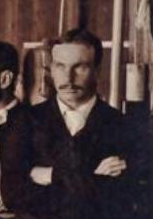
Frank Rattray Lillie (1870-1947)
On June 27, 1870, American zoologist and an early pioneer of the study of embryology Frank Rattray Lillie was born. Lillie is known for his discoveries concerning the fertilization of the egg (ovum) and the role of hormones in sex determination. He was instrumental in the development of the field of embryology. He identified the influence of potassium on cell differentiation and elucidated the biological mechanisms behind free-martins.
Frank Lillie – Early Years
Frank Lillie was born in Toronto, Ontario, Canada. His father was a wholesale druggist and accountant. After attending a laboratory school as a youth, Frank Lillie studied endocrinology and embryology at the University of Toronto. After graduating in 1891 he moved to Massachusetts where he started a position at the Marine Biological Laboratory. Later he became a fellow in zoology at Clark University, where he studied under Charles Otis Whitman, who was influential to the founding of classical ethology A dedicated educator who preferred to teach a few research students at a time, Whitman has made major contributions in the areas of evolution and embryology of worms, comparative anatomy, heredity, and animal behaviour. Whitman supported Lillie and he was able to move his studies to the University of Chicago, where at the age of 24 he received his doctorate degree with summa cum laude in zoology.
Research at the University of Chicago
Except for an interval of six years after receiving the doctoral degree, Lillie’s professional life was intimately connected with the University of Chicago. During the next few years, Frank Lillie was first professor of biology at Vassar College but in 1900 he was called back to Chicago as Assistant Professor of Zoology. In 1906, Lillie was appointed Professor of Embryology and four years later he succeeded Whitman as Chairman of the Department of Zoology, a position which he held until 1931, a span of 21 years. At a meeting of the National Academy of Sciences in 1925, Frank Lillie suggested a committee to be formed in order to begin a national oceanography organization. NAS agreed as long as Lillie was able to raise enough funds and in 1930, the Woods Hole Oceanographic Institution was established. Lillie became the organization’s first president, serving the position until 1939. Lillie first came to Woods Hole in 1891 as a student just graduated from college. From that time until 1946, a period of fifty-five years, he was present at the laboratory every summer. No other person has been associated with the Marine Biological Laboratory for so long a period in its history, or has devoted himself so continuously to its affairs.[1]
Problems of Fertilization
When Frank Lillie began to study embryology, this field of research was still relatively new. He was able to publish his first major work in 1901. He found out that after exposing eggs to abnormal concentrations of potassium, unsegmented eggs underwent cellular differentiation in the absence of mitosis. In 1919, Lillie summarized his findings to that point in ‘Problems of Fertilixation‘, where he concluded that fertilization was a series of timed and irreversible events.
Theory of the Free-Martin
‘The Theory of the Free-martin‘ was published in Science in 1917. Lillie became a pioneer in the study of sex steroids in sexual differentiation. He discovered that sex steroids in the blood controlled differentiation. Back then, Free-martins, sterile female cows born without sex organs, were a perplexing issue for cattle ranchers. Lillie found that free-martins formed when twins shared the same placenta. The hormones from the male twin would then be shared with the female, stunting the growth of her reproductive system. After the 1950s, with the DNA helical structure being unravelled and the increasing knowledge in the field of molecular biology, developmental biology emerged as a field of study which attempts to correlate the genes with morphological change, and so tries to determine which genes are responsible for each morphological change that takes place in an embryo, and how these genes are regulated.
Honors and Later Life
In 1933 Lillie was elected to the American Academy of Arts and Sciences. From 1935 to 1939 he was president of the National Academy of Sciences, to which he was elected in 1915. In 1934 he was elected Honorary Fellow of the Royal Society of Edinburgh, in 1939 he received its Alexander Agassiz Medal. In 1935/36 he headed the National Research Council. Frank Lillie died in Chicago on November 5, 1947.
Implantation | Behavior | MCAT | Khan Academy, [7]
References and Further Reading:
- [1] Frank Lillie at the National Academy of Sciences
- [2] Frank Lillie at the Embryo Project Encyclopedia
- [3] Guide to the Frank R. Lillie Papers 1899–1941 at the University of Chicago Special Collections Research Cente
- [4] Frank Lillie at Wikidata
- [5] Works by or about Frank Rattray Lillie at Internet Archive
- [6] Gilbert, S. F. 2003. Edmund Beecher Wilson and Frank R. Lillie and the relationship between evolution and development, Developmental Biology, 7th edition, Sinauer
- [7] Implantation | Behavior | MCAT | Khan Academy, khanacademymedicine @ youtube
- [8] Timeline of American Zoologists, via DBpedia and Wikidata






Pingback: Whewell’s Gazette: Year 3, Vol. #46 | Whewell's Ghost
Hi,
Very nice Article. Thank you for sharing useful information. Infertility is a Product of [ FHRC] is serving many infertile couples Nationally and globally. FHRC is set up by highly experienced and expertise doctors & gynecologists with more than 25 years experience. FHRC is most reliable and suggested by many couples who had successfully attained parenthood at our center. We strictly follow Indian Council of Medical Research [ICMR] guidelines. We take up every needy infertile couple consultation, initial approach, planning up of treatment in a short duration of time under single visit.